1986
Famous music critic on local television wires, 1986!
In March 1986, I interviewed Alana MacDonald of the trio Devonsquare for an article about the status and experiences of women in pop music.
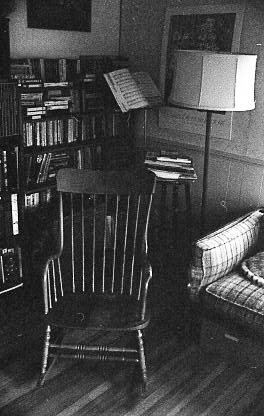
The living room at 506 Preble St., South Portland. The music stand holds a Palmer-Hughes accordion instruction book. Digital scan from black & white negative/Hubley Archives.
MacDonald, singer and violinist for one of the most popular club acts in the Northeast, was friendly and forthcoming. Toward the end of our meeting I felt encouraged to ask about perhaps submitting a few of my songs to Devonsquare.
MacDonald kindly expressed openness to the idea (although it’s hard to imagine that folk-pop trio doing, say, “Little Cries”).
But I never followed up.
That article today doesn’t read like much (especially to a regular viewer of “Nashville”).
But the interview, over coffee at the legendary Portland bistro Deli One, stands out as symbolic of that time in my life.
In recent years I’ve lost sight of how connected I was back then, how many acquaintances I had made as a writer and musician. The same was true for my then-partner, now my wife, Gretchen Schaefer. As manager of Congress Square Gallery, she encountered a steady stream of art makers and consumers*.
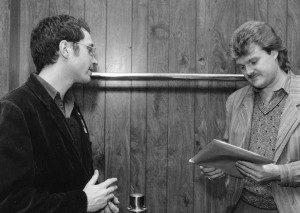
Backstage at the Cumberland County Civic Center in 1985, I give Ricky Scaggs copies of my Sunday Telegram article about him.
By no means are we recluses today, but the steady stream of encounters back then seemed part and parcel of our having “arrived” on the Portland scene. We weren’t in with the In Crowd, but we knew it to say “hi” to.
I talked to MacDonald for “Club Beat,” my music column for the Maine Sunday Telegram. My other interviewees for that piece included Cathie Stebbins, a pop-blues singer big on the local circuit, and Chris Horne, a member of the all-female (“all-chick” to Chris) retro ’60s band The Brood — established players all.
And I never sent MacDonald any songs because I understood, even then, that my offer was less about sharing music than making it clear that I was not just someone who wrote about musicians, but was really a musician too. (See proof of my musical qualifications.)
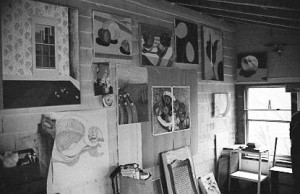
Gretchen’s studio at 506 Preble St., South Portland. Digital scan from black & white negative/Hubley Archives.
In 1986 it was a shaky claim. My band, the Fashion Jungle, had ground to a halt at the end of January, and for the rest of the year I barely touched a guitar, to say nothing about climbing up on a stage. I wrote no songs. I have no recordings from 1986.
This disconnect from what I profess to care so much about must have bothered me; but I don’t remember it. I suspect I was relieved to be done with the uncertainty of it all. I contemplated putting together a solo act, but couldn’t seem to get any traction. I like playing with other people.
So, typically for me, instead getting back up on the Fashion Jungle horse and trying again, I lurched in a new direction. That fall I bought a cheap used 120-bass piano accordion and some Palmer-Hughes instruction books at Starbird Music. And it was love at first honk.
While I was playing little music, and none presentable (Palmer-Hughes’ “Vegetables on Parade,” anyone?), I was hearing a ton of it, thanks to writing assignments from the Guy Gannett newspapers in Portland, Maine. Those included rock and pop record reviews; concert previews and reviews; and features about topics musical and otherwise.
In 1986, in addition to 18 “Club Beat” columns, I did countless Portland Symphony Orchestra and other classical reviews, and covered in depth the sweepstakes for the selection of the PSO’s new conductor. I also reviewed pop and rock, live and on disc.
I advanced the Maine Festival and New Year’s / Portland — remember them? I wrote food stories, art reviews, a Christmas-shopping guide to new books about rock and pop music, and a feature about the stage costumes worn by classical and heavy metal musicians.
I talked with Harry Belafonte, Maria Muldaur, George Shearing, the Kronos Quartet, Sharon Isbin and Christopher Parkening, Simple Minds’ lead singer Jim Kerr, magician David Copperfield and a variety of Maine visual artists. My Smith-Corona typewriter got a workout.
At the same time, I was catching shifts on the copy desk at the Portland Press Herald and the Evening Express. PH shifts ran from mid-afternoon till midnight or later, and Express shifts from 5 or 6 a.m. till early afternoon. A few times I’d show up for an Express shift a few hours after finishing a review or copy-desk stint for the Press Herald.
In short, the “creative renaissance” of 1985, with its metaphorical overtones of sweet dawn and blooming posies, had matured into a blurry high-pressure reality of late nights, early mornings, weekend work, writing and editing and gadding about. It was a hard slog, deficient in down time, but deeply educational.
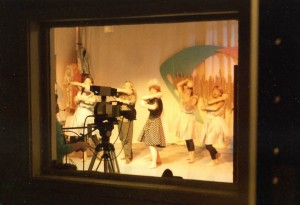
The Swedish Ball Team, seen through the control room window during the cablecast of “Addicted to Show Biz.” Randy Visser photo/SPTV.
1986 was also a year for domestic synergy. After five years together, Gretchen and I moved in together in March, renting a charming duplex in a charming neighborhood, near South Portland’s Willard Beach, amidst not so charming neighbors.
For the first time, I had an actual office, in a spare bedroom, and Gretchen had a large sunporch for her studio. The reality of hard work did not dampen our creative-renaissance ideal, and living together gave it new energy.
We did carve out spare time, and immediately found ways to fill it up. Among them was the local public-access TV station, headquartered at Southern Maine Vocational-Technical Institute, just down the beach from us. We took a couple of TV production courses and began a relationship with South Portland TV director Randy Visser that would last a couple of years, and result in some actual programming.
Gretchen and I each produced and directed a program for SPTV as our final projects for a course. Gretchen’s was “Art Who,” a look at the commercial art world that reflected her connections through the gallery. Her guests were Roger Richmond, who designed the Vietnam Veterans Memorial in Augusta, Maine; Elena Kubler, her colleague at the gallery; and Ellen Schiferl, a professor of art history with whom we had studied at the University of Southern Maine.
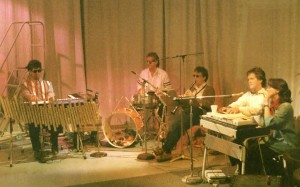
“Addicted to Show Biz”: Charlie Brown, Mike Wiskey, Sean Potter, Will Jackson, Carla Bryson. Randy Visser photo/SPTV.
Meanwhile, I had gotten to know the people of Delux Productions, a Maine musical cabaret troupe that made funny, sharply post-modernist takeoffs on showbiz tropes from the second half of the 20th century.
“We’re no less accessible than ‘I Love Lucy,’ ” Maria “Delux” Locke, one of the troupe’s leaders, told me for a “Club Beat” story about “A Big Big Show With a Big Big Band,” their 1986 summer cabaret series in Old Orchard Beach.
The only difference between Ricky Ricardo’s Tropicana and the Delux cabarets, added her colleague Beth Hartman, “is that we have kind of an ’80s sensibility. We’re not just doing nostalgia . . . It’s a parody, and yet it’s kind of straightforward somehow. It’s a paradox, but it works.”
I approached Delux about appearing on SPTV, and the result was “Addicted to Show Biz.” A half-hour live cablecast, it was a variety show showcasing the best of Delux: host Omar Ricardo (real name: Frank Omar), a Ricky Ricardo wannabe; the acrobatic dancers of the Swedish Ball Team; the suave pop stylings of Will Jackson and Carla Bryson, sitting at the Fashion Jungle’s old Farfisa rock organ; Latin dance numbers; garish / vintage costumes created by Theresa Visinaire (who lent me a songbook of Polish songs for the accordion); Hartman singing Robert Palmer’s “Addicted to Love”; and the jazzy pop of a small combo led by keyboardist extraordinaire Charlie Brown.
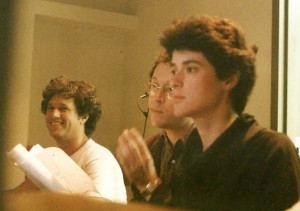
“Addicted to Show Biz” goes live. Director / producer Doug Hubley, center, with technical director Gretchen Schaefer, right, and audio engineer Neal Portnoy. Randy Visser photo/SPTV.
That was some intense evening. It was the first and only time I directed a TV show, and the tensions ran high and the camera angles askew. But it came off, distributed over SPTV’s cable feed to — what? 20, 30 people? Didn’t matter. I was ecstatic. I never heard how Delux really felt about it, but we stayed in touch, so they couldn’t have been too put off.
In a year spent offstage and away from songwriting, it was a huge creative consolation. It was part of an interest in moving-image work that we sustained for a few years and that included a Super-8 sound film based on Dickens’ “Christmas Carol.” (Look for that in November.)
Meanwhile, the wheel of fortune continued to turn. “Addicted to Show Biz” aired on Sept. 16. Just a week or so prior, former Fashion Jungle bassist Steve Chapman and Jeri Kane, whom he’d met in Boston, were married on a beautiful weekend day at Steve’s family cabin on Conway Lake, in New Hampshire. Gretchen, Kathren, Ken and I were among the guests.
Soon the Chapmans moved to Portland. And soon after that, the Fashion Jungle was back.
*In fact, at one point it dawned on us that one artsy couple was buddying up to us pretty much because of what we could do for them professionally. Our get-togethers with this pair, one of whom was a chilly landscapist with some name recognition, were marked by differences in outlook that belied any basis for real friendship. Naifs that we were, we got wise only when our jobs changed and we were no longer of use to them.
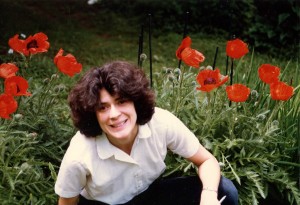
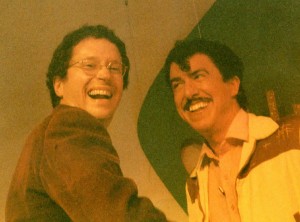
Great post! Lots of interesting stuff.
Doug, interesting stuff. The local access TV show is great, sorry I missed that.
I remember watching you guys make a TV show, but mostly I remember that it was the only time I ever thought Doug was scary. I think intense might not be an adequate word to describe the evening:)